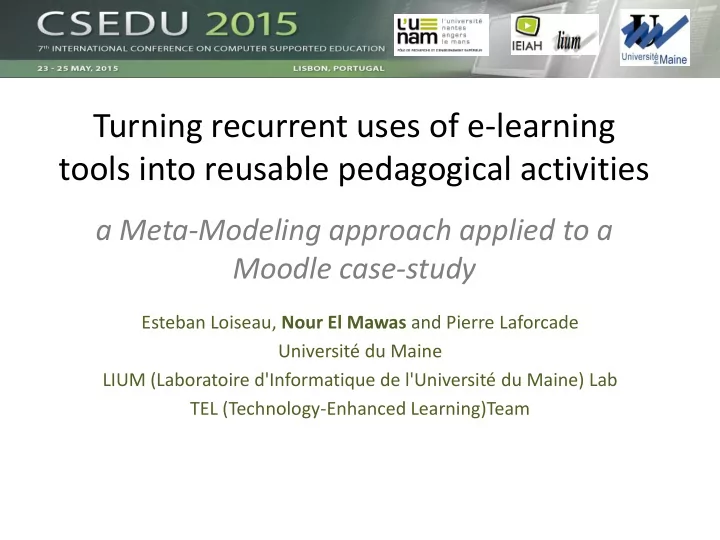

Turning recurrent uses of e-learning tools into reusable pedagogical activities a Meta-Modeling approach applied to a Moodle case-study Esteban Loiseau, Nour El Mawas and Pierre Laforcade Université du Maine LIUM (Laboratoire d'Informatique de l'Université du Maine) Lab TEL (Technology-Enhanced Learning)Team
Research context • LIUM: Computer Science Lab (Le Mans, France) – TEL systems engineering team • GraphiT project – Funded by the French research agency (ANR) – http://www-lium.univ- lemans.fr/~laforcad/graphit/ 24/05/2015 2
The GraphiT Project 24/05/2015 3
Visual Instructional Design Language • A modeling language • To design learning scenarios • Define a visual representation of pedagogical concepts • Support creative thinking and human communication • Do not systematically provide binding mecanisms to popular LMS 24/05/2015 4
Issues • Institutions impose a specific LMS to teachers • Teachers are (sometimes) trained on how to use it – Not how to design learning situations on the LMS • No “out -of-the- box” Binding between LD standard and LMS – Direct “on -the- fly” design on the LMS – Depending on the teacher skills about the LMS Introduction Motivation Related work Our approach Moodle case study Conclusion & Perspectives 24/05/2015 5
Objectives • Provide teachers with graphical learning design language – “compatible” with LMS • Help to focus on the pedagogical aspect of the scenario – Instead of setting-up complex tools • Foster individual reflection about learning design • Improve uses of the existent LMS 24/05/2015 6
Overall architecture 24/05/2015 7
Survey & Interviews • Open and spread through french-speaking higher educations institutions • Up to 21 questions – Learning design skills – LMS skills – LMS user experience • 208 complete answers • Interviews conducted with 20 selected people who answered the survey 24/05/2015 8
Results • Settings screens too complex – Mixing pedagogical and technical parameters • Time consuming when elaborating complex learning situations • Teachers don’t have a common set of design practices • But all use a mix of LMS tools and pedagogical concepts 24/05/2015 9
Requirements • Graphical notation • High level pedagogical blocks • Mixing LMS and abstracted semantics • Editable default implementation (mapping) • Non-visible information • Activity structures 24/05/2015 10
Abstractions • Moodle-specific • Pedagogical activity – Tool or resource based – Focus on one pedagogical use – Hide implementation parameters – Has specific properties • Activity structure – To implement structural strategies – Common in VIDLs 24/05/2015 11
MetaModel 24/05/2015 12
Identification method 1. Analysis of reccurent uses of a specific Moodle tool 2. Identification of tools offering common uses 3. Specification of discriminating criteria 24/05/2015 13
Identification method • R1 The pedagogical activity name is only from a teacher perspective if no students are concerned • R2 Tools participating to the realization of the activity are the elements A12...A1n. • R3 Discriminating criteria are the elements A21...Am1. • R4 Discriminating criteria are expressed as much as possible as a pedagogical question designers have to answer by Yes or No. • R5 Cells intersecting a discriminating criterion and a tool must embed all answers that can implied to choose this tool (Yes/No are both possible if the tool can support both pedagogical cases). • R6 A valid discriminating criterion must cause at least one different answers for one tool. • R7 The matrix is terminated if there is no similar combination of answers for two tools. 24/05/2015 14
Identification method Answer a poll Quiz Choice Feedback Survey 2+ questions ? Yes/No No Yes/No Yes Yes/No No Yes/No Yes Multiple choices ? Pre-populated No No No Yes Time-limit Yes/No No No No Anonymous No No Yes/No No Graded Yes No No No Feedback Yes No Yes No after submission 24/05/2015 15
Mapping Implementation • Using model transformations at run-time – Generated through High Order Transformation • Modifiable through generic weaving model editor 24/05/2015 16
Learning scenario editor • Sirius based diagram editor • 3 levels of diagram – Learning sessions – Pedagogical activities and structures – Moodle tools and resources • Sequencing elements through node connections 24/05/2015 17
Learning scenario editor (wip) 24/05/2015 18
Conclusion & Perspectives Contributions: • Platform specific VIDL • Abstraction of LMS tools based on specific usage and parameters • Automatic mapping through model weaving • Diagram based editor Perspectives: • More complete visual notation • Adding groups and pedagogical objective • More user-friendly editors • Final model transformation for export feature 24/05/2015 19
Turning recurrent uses of e-learning tools into reusable pedagogical activities Thank you! Contact emails: nour.el_mawas@univ-lemans.fr pierre.laforcade@univ-lemans.fr Esteban.loiseau@univ-lemans.fr 20
Recommend
More recommend